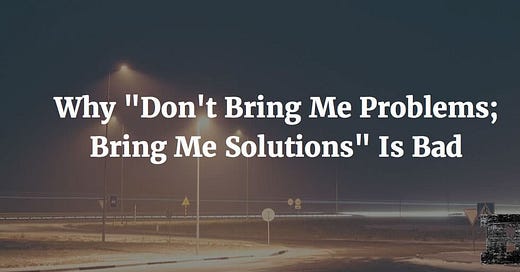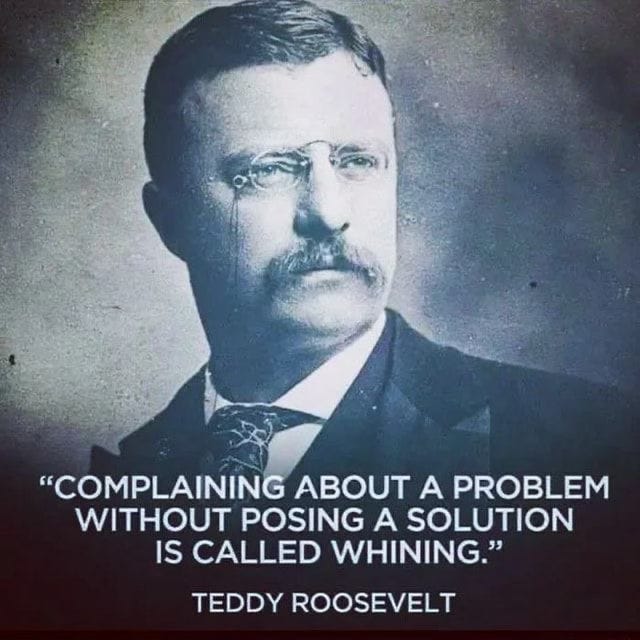I decided to create a section called THE CONTRARIAN a place where unconventional insights confront conventional wisdom.
I reflect on popular phrases and challenge the universal wisdom they claim, because even if there are relative truths to be found in them, I don’t believe in their axiomatic value.
Being a contrarian is not to oppose, but to avoid conformism. It means to challenge assumptions, reason by first principles, redefine what’s possible… It’s about independent thinking to build arguments from the ground up.
Today “Students of Leadership” celebrates the return of the alter ego, The Contrarian, to close the loop on the topic that over the last couple of weeks has been at the center of this newsletter: Problems and Solutions.
The Contrarian pulls back the curtain on a seemingly empowering common phrase that, in practice, can lead to more silence and inaction than you could ever imagine: “Don’t bring me problems, bring me solutions.”
Initial reflection
It’s undoubtedly important to coach people not to whine and complain, to encourage them to offer solutions to daily problems, to act as owners and be leaders. It promotes fast decision making, keeps forward momentum, and increases velocity; hence some version of ‘don’t bring me problems, bring me solutions’ limits swirl, discourage gossips, kills drama. Of course you want people not to act like children, to own their things, to move the ball along and share with you progress made, not paralysis generated at every turn.
Is this the formula to build a team of self-starters?
Contrarian leaders however, look at something deeper because they work to eradicate the ego-driven politics of pre-cooked advocacy that most fear-based cultures breed, where ‘arguments’ tend to only take place after well rehearsed choreographies with senior leaders. God forbid surprises or misalignments!
The contrarian leader is obsessed with creating a culture where people are safe and act empowered, so that they can always bring to the table the brutal facts, those problems nobody wants to hear about, the ones that feel risky to voice without pre-alignment. You would notice I did not say “feel” safe and empowered, I want things to “be”safe, and people to“act” empowered.
Good solutions require deep thinking and our best collective action. Spotting a problem is only the beginning, but crafting the problem statement is an art, sometimes more complex than the creation of the solution itself. So why wouldn’t you want to hear problems? Why wouldn’t you want to help with the creation of the most clear problem statement? Why wouldn’t you want to understand the deeper issues that can be hidden underneath the surface?
For all this, the Contrarian Leader embraces a different mantra :
“Bring me problems, well-articulated problems, not premature solutions.”
Wharton professor Adam Grant, states that the ‘bring me solutions’ mindset creates “a culture of advocacy instead of one of inquiry”.
Imagine the scene: each team member arrives at meetings armed with their solution, ready to champion it, rather than training their minds to engage in a genuine exploration of the problem itself. That’s a room full of advocates, locked into their own perspectives, potentially solving the wrong puzzle with unwavering conviction. What culture do you think it’s more critical for sustainable success?
“The “bring me a solution” approach can also cause employees to shut down in fear, breed a culture of intimidation, and prevent some problems from surfacing until they’re full-blown crises.” HBR, Sabina Nawaz.
You have to reward your team for the quality of the problems they surface and train them to become masters in the art of solution finding.
Think for a moment about James. Sabina Nawaz, writing in the above mentioned Harvard Business Review article, shares the story of a company president working on a disruptive service, James, who has “unpleasant reactions when staff raises problems”. So, what happenes? His team, fearing his temper and raised voice, learned to filter their news. They became adept at presenting only the rosy picture, leaving James “blind to any potential issues”. The result? Valuable time was wasted as team members huddled in offices, not problem-solving, but “licking their wounds after James’ outbursts”. Does this sound like empowerment to you? Or does it echo the chilling silence born of fear?
As we already pointed out, the initial ideal behind “don’t bring me problems” is understandable, managers want to avoid a “culture of complaining”. But Nawaz astutely differentiates between complaining without aim and communicating openly and clearly potential pitfalls, areas of concern and risk. Raising a valid concern early is not whining; it’s an early warning system.
Nawaz offers a powerful alternative: “Require problem statements instead of complaints”. What’s the difference? A complaint is often absolute, accusatory, and superficial. Think of: “Group Blue never hits their deadlines, and we’re always left holding the bag”. It’s a statement of frustration, doesn’t help much.
Now contrast that with a problem statement: “In the past six months, Group Blue has missed deadlines four times, by an average of 6.5 days. In two cases we were also unprepared to meet the deadline. However, in the other two cases our group completed our part of the project on time, but we had to work weekends to integrate Blue’s late work so that it wouldn’t impact the customer”.
Notice the shift? Objective facts replace absolutes. Observations replace judgments. Accountability is acknowledged. The focus moves from blame to understanding the underlying factors. “Because the presenters acknowledge their part in the problem, you know they’re open to being part of the solution, not just blaming others”.
This shift in approach also creates a safer environment. As Nawaz highlights, even at Microsoft, “our reviews with Bill Gates often included detailed discussions about problems”. Gates himself understood that “one of his most important jobs as CEO was to listen for bad news so that he could act on it”. Discussing issues openly allowed for a new perspective on challenges.
By inviting the early surfacing of problems, we “reduce fear and increase empowerment and the speed of problem resolution”. As Harvard Business School professor Frances Frei wisely notes,
“Identifying problems can be a solo sport, but finding solutions rarely is”.
Wrapping up the topic we unfolded over the past 3 weeks, these are some of the most important messages:
Reframing is a real super power.
Driving the new vs fixing the old elevates your leadership.
Don’t complain, don’t judge; bring problem statements instead.
Well articulated problems are far more valuable than premature solutions.
The quality of your questions, not the strength of your declamations, reflects the depth of your thinking and the vision of your leadership.
P.S. Before I go, here you have “The Treat,” where I share some of the music that kept me company while writing … Enjoy as you bid farewell to this post
“Lead yourself, Learn to live. Lead others, Learn to Build.”
If you enjoyed reading this post consider subscribing to the newsletter for free, joining the community and sharing your thoughts.








Amen. If you take this attitude, you can’t be surprised when people just stop telling you about the problems in your organization. And of course that never works out well.